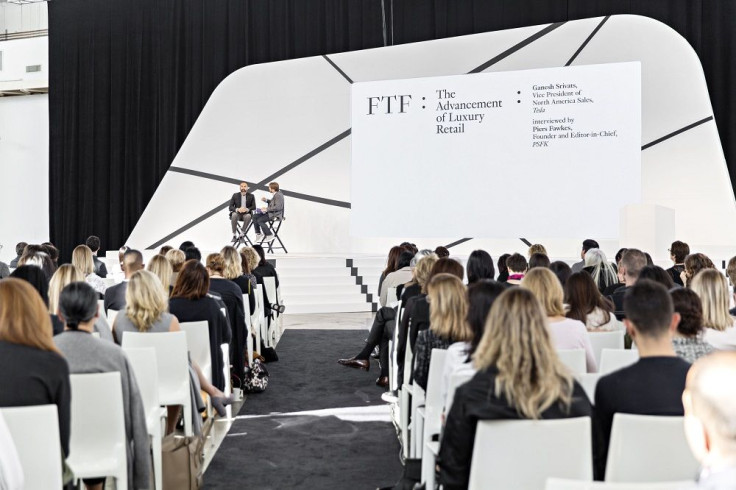How Tesla Makes You Buy Cars: Online Stores, Mall Shops Redefine Retail Experience

You might not necessarily think “retail” when the name “Tesla” is mentioned. But by doing away with the franchise dealership model of traditional automotive companies, the San Francisco Bay Area-based company is, in fact, behaving in a way that would liken it to a luxury retailer. The company recently opened a retail space in a Nordstrom in Los Angeles’ shopping area The Grove, and another store space in New York City's artistically inclined Red Hook neighborhood.
Enter Tesla Motor Inc’s vice president of North America sales and marketing, Ganesh Srivats. His name might ring a bell for those familiar with the fashion industry. Srivats was a former retail and strategy executive at Burberry and came to Tesla after 16 years in retail, luxury and strategy. In July 2015, Srivats stepped into his current role and was tasked with advancing the company’s image as a major player in the luxury automotive sector.
Srivats addressed attendees Thursday at the third annual 2016 Fashion Tech Forum to discuss how Tesla was advancing the luxury retail model. The Fashion Tech Forum, which was hosted this year at Brooklyn’s Duggal Greenhouse, saw tech CEOs, fashion retailers, designers and engineers sitting side-by-side to participate in discussions on the future of fashion, retail and technology. Among them were major players in e-commerce like Rent the Runway’s CEO and co-founder Jennifer Hyman, and other Silicon Valley heavy hitters like and Snapchat’s director of product revenue Peter Sellis and Intel’s vice president of New Technology Group Sandra E. Lopez.

Srivats, who has a robust background in luxury, fashion and technology, said luxury fashion retailers and Tesla have more in common than you might think. Tesla has become the "see now, buy now" brand of luxury car retail, thanks to the immediacy and speed of its output. The company does not sell through dealerships, but through galleries and sleek, modern stores. It’s direct to consumer.
“If you’re profit-minded and you have all of these gas-guzzling SUVS that are selling really fast, what incentive do you have to get out there and re-evangelize a new technology that’s going to be hard to sell and when you have all of this other product that moves faster?” Srivats asked, addressing the crowd. “It’s for these reasons that we decided to move into the retail space because we have to control the customer experience, we have to take the ownership to educate people and we have to make sure that experience is physical and real.”
A goal in streamlining the vehicle purchasing process in Tesla stores is to have the Tesla stores function very similarly to making an online purchase. Srivats said “product specialists” have replaced salespeople and stores will become more “intuitive.”
“One of the things that you will see evolving at Tesla stores in the future is the intuition behind retail. When you go online at home, no one sits next to you and tells you where to click,” he said. “We’re talking about the autonomous store experience as opposed to the assisted store experience.”
Shoppers can more or less purchase a Tesla online. Everything, short of actually walking away with the car, can be handled through its site.
“We spend a lot of time thinking about simplification – one touch contracts, one-touch leasing. So you can speed up the process. You can go into your iPhone right now and buy a Tesla. And that’s how we’re going to scale. It's through the diversification of ways in which we are going to reach people,” he said.
Tesla, which was founded in 2003, released its first Tesla Roadster in 2008. As of March, the company had sold nearly 125,000 electric cars around the world. Since then, the company debuted its forthcoming mass-market EV vehicle, the Model 3 sedan, opened its Gigafactory (which will reportedly double the world’s production of lithium batteries, according to Srivats) and purchased SolarCity, the solar energy company, for a cool $2.6 billion in shares in August.
Tesla’s chief executive officer, Elon Musk, has said he has a plan to “accelerate” its electric car production. The goal is 500,000 vehicles rolling out by 2018 and a staggering one million vehicles by 2020. To get there, the company announced this week plans to double the size of its 4.5 million square foot Fremont factory to accommodate the volume of Model S, Model X and, now, the new Model 3.
Here is where Srivats’ background in retail and the Burberry connection comes into play. Burberry, a British luxury heritage brand that brings to mind plaid prints and classic trench coats, has actually been a major player in adopting tech and integrating it into both its brand and its retail strategy. You can hop on Snapchat, for example, and play with custom sponsored Burberry filters and watch its Snap Ads. The British luxury brand was also one of the major design houses, along with Ralph Lauren and Tommy Hilfiger, to adopt the see now, buy now runway collection, offering its spring 2017 clothing straight off the runways.
“You have to allow for open experimentation and taking chances," Srivats said. "At Burberry, the company was really good at doing that, too."
In Tesla's second-quarter update report from August, the car company detailed its plans to open a new retail location “every four days on average during the remainder of Q3 through Q4.” It currently counts close to 200 retail locations.
“We want to be where the customers already are. You want to be where the customers are walking up and down the street, buying their coffee or buying their clothes,” Srivats said.
He added: “Between fashion and tech, that’s one thing we simply share: It’s this constant challenge to innovate and to stay ahead of that curve.”
© Copyright IBTimes 2024. All rights reserved.




















